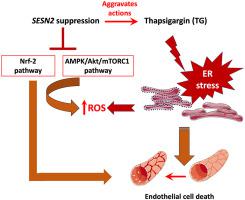European Journal of Pharmacology ( IF 4.2 ) Pub Date : 2021-06-09 , DOI: 10.1016/j.ejphar.2021.174247
Munazza T Fatima 1 , Maram Hasan 1 , Shahenda S Abdelsalam 1 , Siveen K Sivaraman 2 , Heba El-Gamal 1 , Muhammad A Zahid 1 , Mohamed A Elrayess 3 , Hesham M Korashy 1 , Asad Zeidan 4 , Aijaz S Parray 5 , Abdelali Agouni 6

|
Endoplasmic reticulum (ER) stress is an inflammatory response that contributes to endothelial cell dysfunction, a hallmark of cardiovascular diseases, in close interplay with oxidative stress. Recently, Sestrin2 (SESN2) emerged as a novel stress-inducible protein protecting cells from oxidative stress. We investigated here, for the first time, the impact of SESN2 suppression on oxidative stress and cell survival in human endothelial cells subjected to pharmacologically (thapsigargin)-induced ER stress and studied the underlying cellular pathways. We found that SESN2 silencing, though did not specifically induce ER stress, it aggravated the effects of thapsigargin-induced ER stress on oxidative stress and cell survival. This was associated with a dysregulation of Nrf-2, AMPK and mTORC1 signaling pathways. Furthermore, SESN2 silencing aggravated, in an additive manner, apoptosis caused by thapsigargin. Importantly, SESN2 silencing, unlike thapsigargin, caused a dramatic decrease in protein expression and phosphorylation of Akt, a critical pro-survival hub and component of the AMPK/Akt/mTORC1 axis. Our findings suggest that patients with conditions characterized by ER stress activation, such as diabetes, may be at higher risk for cardiovascular complications if their endogenous ability to stimulate and/or maintain expression levels of SESN2 is disturbed or impaired. Therefore, identifying novel or repurposing existing pharmacotherapies to enhance and/or maintain SESN2 expression levels would be beneficial in these conditions.
中文翻译:

Sestrin2 抑制加剧内皮细胞的氧化应激和细胞凋亡,内皮细胞受到药物诱导的内质网应激
内质网 (ER) 应激是一种炎症反应,会导致内皮细胞功能障碍,这是心血管疾病的标志,与氧化应激密切相关。最近,Sestrin2 (SESN2) 作为一种新型应激诱导蛋白出现,保护细胞免受氧化应激。我们在这里首次研究了SESN2抑制对受到药理学(毒胡萝卜素)诱导的 ER 应激的人内皮细胞氧化应激和细胞存活的影响,并研究了潜在的细胞途径。我们发现SESN2沉默虽然没有特异性诱导内质网应激,但它加剧了毒胡萝卜素诱导的内质网应激对氧化应激和细胞存活的影响。这与 Nrf-2、AMPK 和 mTORC1 信号通路的失调有关。此外, SESN2沉默以累加的方式加剧了毒胡萝卜素引起的细胞凋亡。重要的是,与毒胡萝卜素不同, SESN2沉默会导致 Akt 的蛋白表达和磷酸化急剧下降,Akt 是 AMPK/Akt/mTORC1 轴的关键促生存中枢和组成部分。我们的研究结果表明,患有以 ER 应激激活为特征的疾病(如糖尿病)的患者,如果其刺激和/或维持 SESN2 表达水平的内源性能力受到干扰或受损,则可能面临更高的心血管并发症风险。因此,识别新的或重新利用现有的药物疗法来增强和/或维持 SESN2 表达水平在这些情况下将是有益的。

































 京公网安备 11010802027423号
京公网安备 11010802027423号